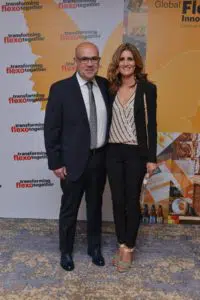The start of something big for CR Serigrafia
Roberto Chiapuzzo believes his company, CR Serigrafia, is at the beginning of something special in packaging — flexo-printing directly onto conical plastic containers. “This is real innovation,” enthuses Chiapuzzo. “Eliminating sleeves takes cost and materials out of the process, and we believe it’s the future.”
The independent judging panel of the previous Global Flexo Innovation Awards agreed with the judgement, honoring CR Serigrafia with a Gold Award for innovation in three categories: converting jobs to flexo from other processes, production workflow efficiency, and sustainable print. “For a small business — we are just ten people — this was a wonderful achievement, but we have worked hard for it,” says Chiapuzzo.
Based in Tortona, to the south of Milan, CR Serigrafia has been in the prepress business almost 30 years, specializing in cylindrical packaging in the beginning, initially for screen and offset printing. In 2003, what Chiapuzzo calls “our flexo adventure” began when CR Serigrafia became a beta site for the KODAK ThermoFlex technology. In 2010 KODAK FLEXCEL NX arrived and, he says, “changed the game, opening up new possibilities for achieving consistently high quality on conical products. It was the moment when we realized that the future is flexo.”
 CR Serigrafia did not travel the road to the Global Flexo Innovation Awards presentation in Istanbul alone: for company it had its customer Esbe, a leading producer and printer of plastic food containers. “Our two companies have worked together for some years,” says Chiapuzzo, “ever since we started using FLEXCEL NX. The technology has been very profitable for both of us!”
CR Serigrafia did not travel the road to the Global Flexo Innovation Awards presentation in Istanbul alone: for company it had its customer Esbe, a leading producer and printer of plastic food containers. “Our two companies have worked together for some years,” says Chiapuzzo, “ever since we started using FLEXCEL NX. The technology has been very profitable for both of us!”
Seeking alternatives
Like everyone in packaging, Esbe is always on the lookout for a new way of doing things. They set out to find an alternative to the traditional way of printing directly onto containers — dry offset. “The process is well-established,” explains Chiapuzzo, “but dry offset does have some drawbacks. The inks are applied wet-on-wet, so drying can be a problem, and so can register. Plus, there’s always the possibility of the colors mixing, and achieving sufficient white coverage on clear containers can be difficult. High-quality, high-impact imagery on packs is more and more important, and that was the main thing we were looking for.”
The search for another process took Esbe to Italian manufacturer Omso, a leader in direct-to-container printing using various processes, including flexo, and in September 2012, an Omso Servocup 237 system was installed.
“It’s quite a machine — and the only one in Europe,” says Esbe director, Dr. Daniele Durzini, taking up the story. “It has 20 mandrels, arranged in a round configuration, and prints up to seven colors on tapered plastic shapes, at speeds up to 400 items an hour. A key feature compared to dry offset is that the colors are printed and dried one at a time, so there’s no color pollution, and an optical centering device ensures perfect register.”
Final piece
The final piece in the quality jigsaw is delivered by the FLEXCEL NX plates, says Esbe’s production manager Stefano Fortusini. “The results we’re getting are superb. We’ve been able to increase the line-screens from 48 to 60, giving finer detail and a much better color range, particularly on halftones and areas of medium shading. Another big benefit is, we can often print special spot and Pantone colors out of the CMYK ink set, and as for whites, they’re now perfect. Overall, the level of quality is almost photographic, which would have been unthinkable using dry offset.”
He goes on to list other benefits of the new approach, both on the press — where productivity has increased — and for Esbe’s sustainability credentials. “Make-readies are ultra-fast, because the FLEXCEL NX plates are so easy to calibrate and set up, and printing speeds high. We’ve eliminated solvents during cleaning and tooling, and are using a lot less ink than with dry offset — as much as 40% less on some jobs. Add in the absence of substrates, and the process is much more environmentally sound.”
Paying more for quality
“In a cost-conscious, price-competitive market like packaging, it is difficult to justify charging higher prices for prepress”, says Chiapuzzo. “But the results we deliver, especially on packaging with complex images, justify the price difference. Our greatest satisfaction is then when customers call us after receiving the final product, saying ‘it’s perfect’!”